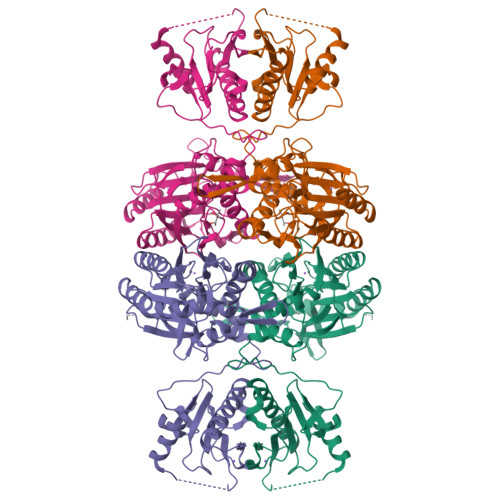Crystal structure of the worm NitFhit Rosetta Stone protein reveals a Nit tetramer binding two Fhit dimers.
Pace, H.C., Hodawadekar, S.C., Draganescu, A., Huang, J., Bieganowski, P., Pekarsky, Y., Croce, C.M., Brenner, C.(2000) Curr Biol 10: 907-917
- PubMed: 10959838
- DOI: https://doi.org/10.1016/s0960-9822(00)00621-7
- Primary Citation of Related Structures:
1EMS - PubMed Abstract:
The nucleotide-binding protein Fhit, among the earliest and most frequently inactivated proteins in lung cancer, suppresses tumor formation by inducing apoptosis. In invertebrates, Fhit is encoded as a fusion protein with Nit, a member of the nitrilase superfamily. In mice, the Nit1 and Fhit genes have nearly identical expression profiles. According to the Rosetta Stone hypothesis, if the separate Nit and Fhit genes could be shown to occur in the same subset of genomes (that is, to share a phylogenetic profile), then the existence of a fusion protein in invertebrates and the coordinated expression of separate mRNAs in mouse suggest that Nit and Fhit function in the same pathway and that the structure of invertebrate NitFhit may reflect the nature of Nit-Fhit interactions. To satisfy the phylogenetic profile criterion for functional significance of protein fusion events, we cloned additional Nit homologs from organisms with Fhit homologs. We used fluorescent nucleotide analogs of ApppA to follow the purification and to characterize the nucleotide specificity of NitFhit from Caenorhabditis elegans, crystallized the 200 kDa tetrameric complex, and solved the structure of NitFhit from a single mercury derivative phased by two-wavelength anomalous diffraction. Nit monomers possess a new alpha-beta-beta-alpha sandwich fold with a presumptive Cys-Glu-Lys catalytic triad. Nit assembles into a tetrameric, 52-stranded beta box that binds Fhit dimers at opposite poles and displays Nit active sites around the middle of the complex. The most carboxy-terminal beta strand of each Nit monomer exits the core of the Nit tetramer and interacts with Fhit. Residence in the NitFhit complex does not alter the nucleotide specificity of Fhit dimers, which are oriented with ApppA-binding surfaces away from Nit.
Organizational Affiliation:
Structural Biology and Bioinformatics Program, Kimmel Cancer Center, Thomas Jefferson University, Philadelphia, Pennsylvania 19107, USA.



















